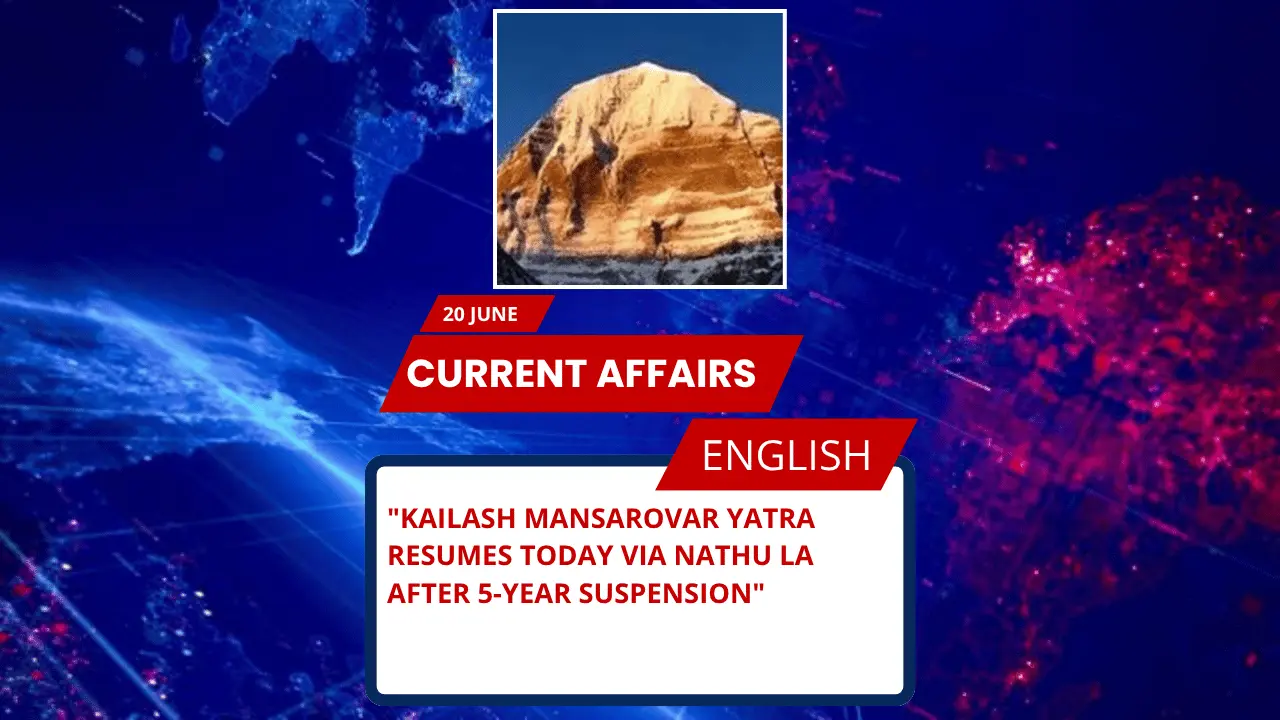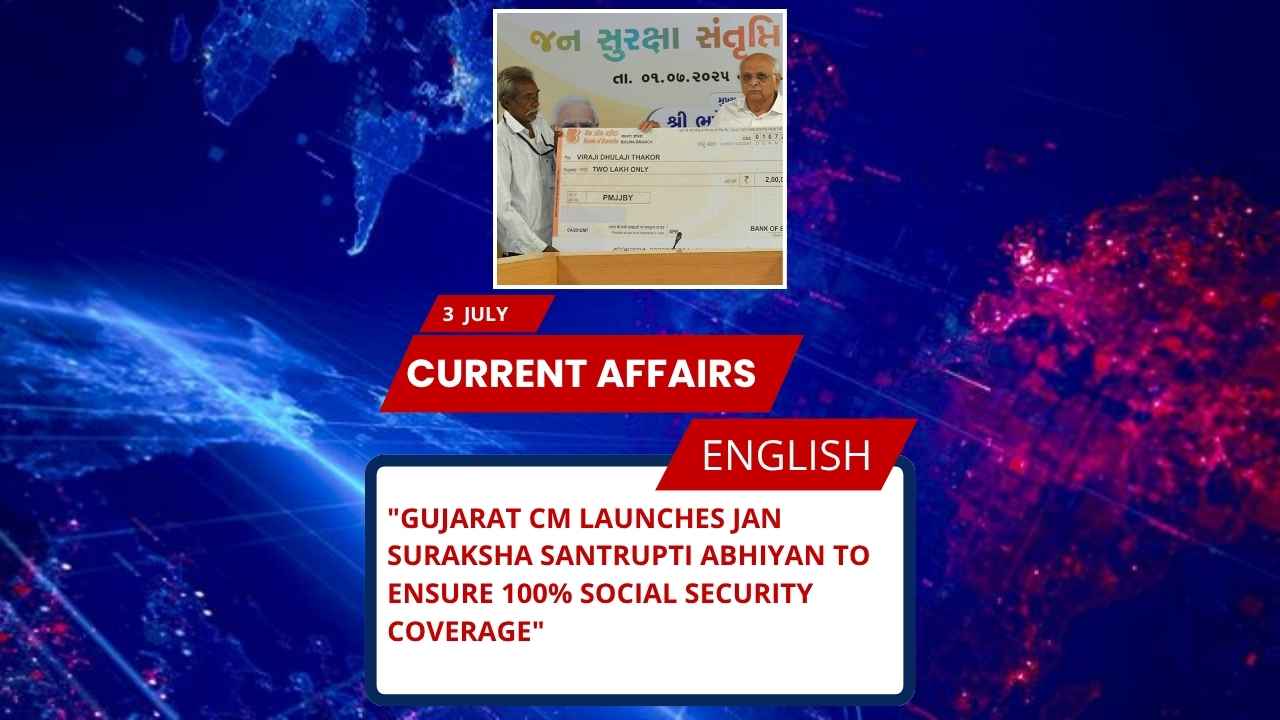
Key Points for SSC & Other Government Exams
- Kailash Mansarovar Yatra 2025 resumed today from Nathu La Pass, Sikkim, after a 5-year halt.
- Suspended since 2020 due to COVID-19 and India-China border tensions.
- 750 pilgrims selected via computerized draw by Ministry of External Affairs (MEA).
- Seen as a step towards India-China normalisation.
- Flagged off by Sikkim Governor Om Prakash Mathur at 8:45 AM.
- MEA is the official organiser of the Yatra.
- Two routes: Lipulekh (Uttarakhand) and Nathu La (Sikkim); both fully motorable.
- Significant to Hindus, Buddhists, and Jains.
Important State and Organization Facts
Sikkim (State)
- Capital: Gangtok
- Chief Minister: Prem Singh Tamang (Golay)
- Governor: Om Prakash Mathur
- Important River: Teesta
- National Park: Khangchendzonga National Park (UNESCO Site)
- Borders With: China (Tibet), Bhutan, Nepal
Ministry of External Affairs (MEA)
- Minister: Dr. S. Jaishankar
- Role: Handles India’s external relations and cultural diplomacy
- Organizer of Kailash Mansarovar Yatra
Tibet Autonomous Region (China)
- Capital: Lhasa
- Location of: Mount Kailash and Lake Mansarovar
- Importance: Religious and geopolitical relevance to India
Yatra Resumes on June 20, 2025
The spiritually significant Kailash Mansarovar Yatra resumed today, June 20, 2025, from Nathu La Pass in Sikkim, ending a 5-year hiatus. The inaugural batch, comprising 36 pilgrims, was flagged off at 8:45 AM by Governor Om Prakash Mathur.
Multiple departments, including the Tourism and Civil Aviation Department, coordinated to ensure a smooth start to the Yatra.
Why Was the Yatra Suspended?
The Yatra was halted in 2020 due to the global COVID-19 pandemic. The suspension continued as border tensions escalated between India and China, especially following the standoff at the Line of Actual Control (LAC) in Eastern Ladakh.
Diplomatic Developments
In January 2025, Foreign Secretary Vikram Misri met with his Chinese counterpart, Sun Weidong, in Beijing, where both agreed to restart the Yatra and rebuild diplomatic ties through cultural and religious engagement.
Route, Selection & Infrastructure
Pilgrim Selection for 2025
The Ministry of External Affairs received over 5,561 applications, including 1,537 women. From these, 750 pilgrims were selected through a computerised, gender-balanced draw.
- Lipulekh Route (Uttarakhand): 5 batches
- Nathu La Route (Sikkim): 10 batches
Both routes are now fully motorable, reducing the physical strain and making the pilgrimage more accessible.
Cultural Significance
Mount Kailash is sacred in Hinduism as the abode of Lord Shiva. Lake Mansarovar is considered a purifying holy site. The Yatra is also revered in Buddhism, Jainism, and the Bon religion, making it a globally respected spiritual pilgrimage.
Strategic and Symbolic Implications
The revival of the Yatra indicates improving India-China diplomatic ties, possibly paving the way for broader people-to-people cooperation and confidence-building. It also boosts religious tourism and reopens a critical cultural channel between the two Asian powers.
MCQs for Exam Preparation
Q1. On which date did the Kailash Mansarovar Yatra resume in 2025?
A) June 10
B) June 15
C) June 20
D) June 25
Answer: C) June 20
Q2. Which Indian state is associated with the Nathu La route of the Yatra?
A) Himachal Pradesh
B) Arunachal Pradesh
C) Sikkim
D) Uttarakhand
Answer: C) Sikkim
Q3. How many total pilgrims have been selected for the 2025 Kailash Mansarovar Yatra?
A) 500
B) 600
C) 750
D) 1000
Answer: C) 750
Q4. Who flagged off the first batch of Yatris in 2025?
A) Prime Minister of India
B) CM of Sikkim
C) Governor Om Prakash Mathur
D) Minister of External Affairs
Answer: C) Governor Om Prakash Mathur
Q5. Which organisation is responsible for organising the Yatra?
A) Ministry of Culture
B) Ministry of Defence
C) Ministry of External Affairs
D) Ministry of Tourism
Answer: C) Ministry of External Affairs
UPSC-Style FAQs (Answer Writing Format)
Q1. What is the geopolitical and diplomatic significance of resuming the Kailash Mansarovar Yatra in 2025?
Answer:
The resumption of the Kailash Mansarovar Yatra in 2025 serves as a strategic and diplomatic gesture in India-China relations. The Yatra had been suspended since 2020 due to COVID-19 and escalating border tensions. Restarting it reflects a conscious attempt to normalise ties through people-centric diplomacy.
The pilgrimage, religiously significant to Indians, acts as a soft power tool that promotes mutual respect and cultural cooperation. The meeting between Indian Foreign Secretary Vikram Misri and Chinese counterpart Sun Weidong set the tone for this revival.
In the broader regional context, it contributes to trust-building, eases border apprehensions, and reflects India’s use of spiritual diplomacy to balance hard geopolitical realities.
Q2. Analyze the role of the Ministry of External Affairs in facilitating international religious pilgrimages such as the Kailash Mansarovar Yatra.
Answer:
The Ministry of External Affairs (MEA) plays a pivotal role in organising and coordinating the Kailash Mansarovar Yatra. It ensures diplomatic coordination with China, selects pilgrims through a transparent and inclusive mechanism, and manages logistical support via state governments.
By ensuring the Yatra’s continuity, even amidst strained bilateral relations, the MEA reinforces India’s commitment to upholding cultural traditions while strengthening foreign relations. It also uses the pilgrimage to project India’s soft power, enhance its diplomatic image, and demonstrate its responsiveness to citizen-centric spiritual needs.
Q3. Discuss the religious significance of Mount Kailash and Lake Mansarovar.
Answer:
Mount Kailash and Lake Mansarovar hold deep religious importance across multiple faiths. In Hinduism, Mount Kailash is revered as the abode of Lord Shiva, and Mansarovar is believed to be a source of spiritual purification.
Jains associate the mountain with Rishabhdev, their first Tirthankara, while Buddhists consider it sacred as the dwelling of Demchok, symbolising ultimate bliss.
The Bon religion, native to Tibet, also venerates the region. This cross-religious reverence makes the site one of the most spiritually significant places in Asia, attracting pilgrims from around the world.







